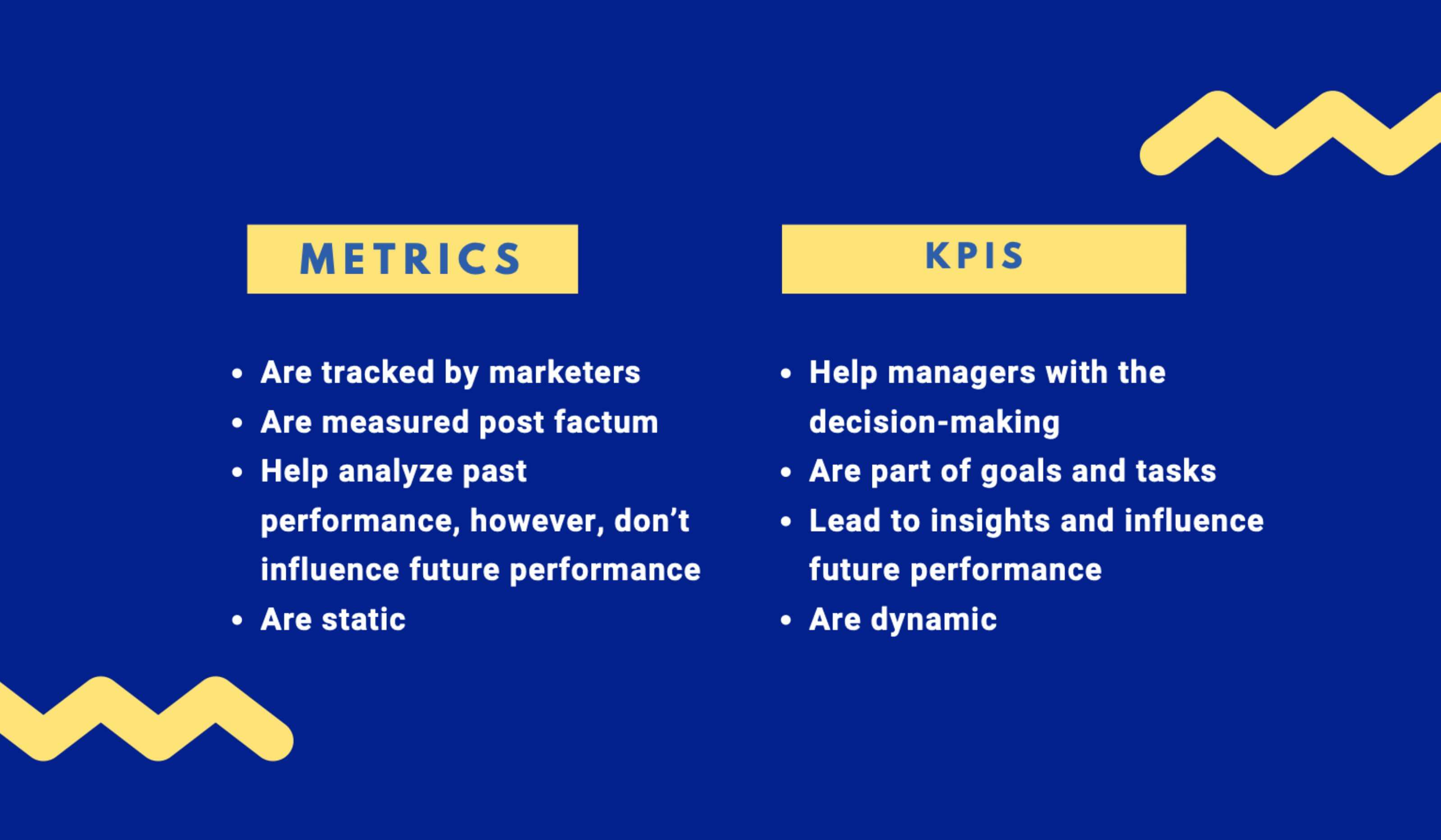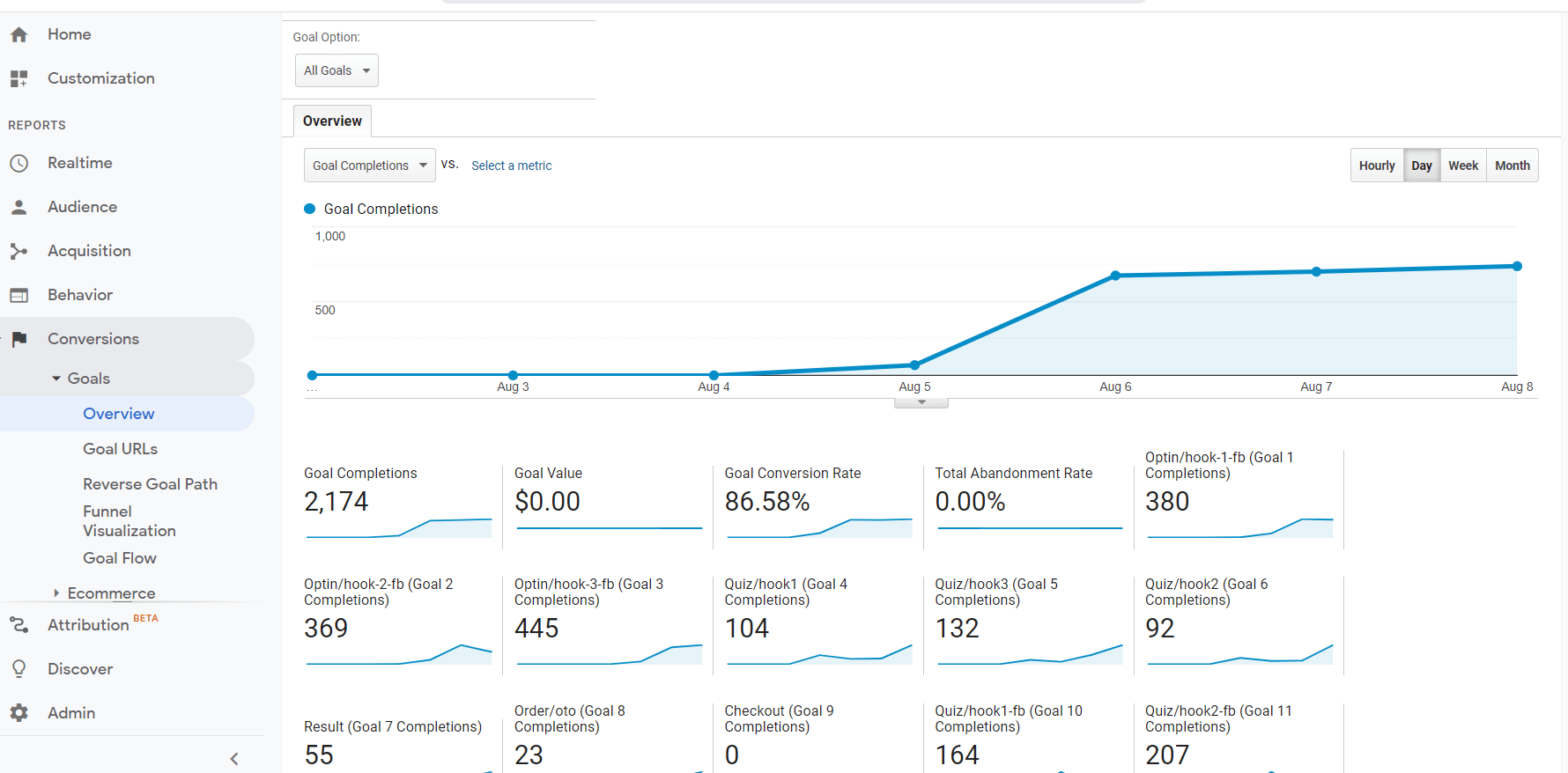James Cook Media Blog

Top Marketing Metrics
Increased sales and revenue are a sign that your business is moving in the right direction. However, you still need to know how effective your marketing efforts are and which channels you can improve. This is where marketing metrics and KPIs enter the game. Continue reading to learn about key marketing metrics and KPIs every business should track to keep its marketing execution on point.

What Is The Difference Between Marketing Metrics And KPIs?
A metric is something that you can count, such as the number of users, events, or transactions. It's just a number, and how you interpret that number is up to you.
KPI is a key performance indicator that is usually measured as a percentage and has a certain norm. For example, by comparing your actual KPI with the market average, you can come to a conclusion about the performance of your business.

Marketing And Sales Performance Metrics
What's going on with sales? Is your website effective enough? Have your marketing efforts paid off over the past few months? Key marketing and sales metrics and KPIs will help you find answers to these questions.
#1. Conversion rate
CR is the conversion rate. This is a metric that helps you see how many of your website visitors ended up ordering or buying something, depending on what you indicated as a conversion goal in Google Analytics or any other analytics service.
CR = (total number of orders / total number of visitors) x 100%
If you set up goals in Google Analytics, you can see the total number of conversions and CR in the "Conversions - Goals - Overview" report:

#2. Click-Through Rate
CTR is a click-through rate. If you need to know the percentage of people who saw your ad and clicked on it, this is the right metric for you. You can compare the CTR for all of your ads and determine the most and least performing campaigns.
СTR = (total number of clicks / total number of views) х 100%
Note: clicks are not yet a conversion. If your goal was not a page visit, CTR is more of an intermediate metric.
#3. Cost Per Click
Cost per click, or CPC, is the amount you pay to the ad site for each click on your ad. This metric will help you measure the cost-effectiveness of your paid ad campaigns.
CPC = money spent on ad placement / total clicks
Google Ads displays this information in auctions for your keywords. If you link your Ads and Google Analytics accounts, you can see CPC in GA reports as well.
NOTE: Join Storytelling In Digital Age Masterclass to learn more about how you can attract and engage your ideal customers using the art of storytelling!
#4. Cost Per Action
Cost per action, or CPA, is the amount you pay to the ad platform when the user takes the target action. You decide which action is to be considered as the target one. This can be a subscription to a newsletter, a callback request, registration for a webinar, etc.
CPA = ad spend / actions
#5. Cost Per Lead
This indicator is even more interesting than the previous one. It differs in that you pay for the contact information of a person potentially interested in your offer. Thus, for CPL, the “target action” is filling out a form and providing contact information.
CPA = ad spend / number of leads
#6. Customer Acquisition Cost
Customer acquisition cost, or CAC, is the amount you spend on average to acquire each new customer. It includes advertising costs, the marketing department’s salaries, software costs, designers’ payroll, etc.
If you're looking for a specific CAC for your business, we recommend you not to. It’s better to compare CAC with LTV (Lifetime Value). In fact, a business is successful if its LTV is 3 times the CAC. Don’t worry, we’re going to talk about LTV as well in this article.
There is one more important thing to know about CAC: your ad spend can pay off in one or a couple of months, leading to a conversion. The period that shows how long it takes for customers to convert is called the conversion window. In Google Analytics, you can find this metric by going to Conversions → Multi-Channel Funnels → Time to Conversion (Time Lag):

#7. Return On Ad Spend
Return on ad spend, or ROAS is one of the most important KPIs for measuring the effectiveness of online marketing. ROAS is the profit your company makes for every dollar spent on advertising.
There are several ways to calculate ROAS, here’s one of the most popular:
ROAS = ad campaign revenue / ad spend x 100%
By comparing this KPI across all campaigns, you can easily tell if a certain campaign is effective. If your ROAS is higher than 100%, the campaign is successful, if it is lower, then you spend more than you earn.
#8. Return On Investment And Return Marketing Investment
ROI (Return on Investment) and ROMI (Return on Marketing Investment) will show the effectiveness of your marketing investment.
ROI (return on investment) is an indicator of the effectiveness of your investment in the business.
ROI = (income from money invested - total money invested) / total money invested x 100%
On one hand, a good ROI (technically) is anything above 0.1%. For many channels (for example, contextual advertising), ROI equalling to 20% is very good.
On the other hand, a great ROI is anything above 200%.
Note: ROI is only a way to determine if you are moving in the right direction and change it in time if anything is wrong. At the same time, ROI is a useful metric for business analytics. If you are looking for investors, the first thing you will be asked about is the ROI of your business.
What is ROI in advertising? Same thing, but we consider only investments in marketing. Marketing ROI, aka ROMI shows the return on advertising. This is the only difference between ROMI and ROI. As a digital marketing agency, we deal closely with ROMI.
ROMI = (Marketing Income - Marketing Cost) / Marketing Cost x 100%
#9. Lifetime Value
LTV (Lifetime Value) shows how much income you get from a customer when they use your services or products (throughout the whole period of your interaction). This metric can be actual (the volume of all the profits from purchases made by the customer) or projected (the total income you expect to receive from that customer). The simplest formula for calculating customer lifetime value looks like this:
LTV = lifetime x average income per user

#10. Customer Retention Rate
How often do users come back to your website? Or do they make a purchase and leave for good? Attracting new customers is much more expensive than "reactivating" existing, but temporarily inactive ones. This is why it is important to monitor the customer retention rate (CRR).
CRR = (number of clients at the end of the period - new clients) / number of new clients x 100%
NOTE: The Storytelling In The Digital Age Masterclass is a unique opportunity to deep dive into the world of digital marketing to take your business to a new level. Click here to learn more.
Marketing Services By James Cook Media
If you need to develop a first-class marketing strategy and get it implemented, you are one step away from making it real. At James Cook Media we know how to make your business work for you. We are a respected international marketing agency that really cares about its clients. Cooperating with us you get:
A team of marketers, filmmakers, artists, and developers with extensive experience in marketing and funnel-building with a wide list of success cases.
A sophisticated marketing and business strategy based on your target audience, business goals, and current market conditions.
A sales funnel, specifically, an automated system that converts leads into paying customers.
Paid traffic implementation so that you can attract your best audience.
Continuous support of your marketing initiatives.
We are here to help you with building and executing your effective marketing strategy. Click here to learn more about our services and welcome on board!
Final Thoughts About Marketing Metrics And KPIs
The marketing metrics and KPIs we've covered in this article are just the tip of the iceberg. However, they give you quite a comprehensive overview of how successful your marketing efforts are. Calculating and analyzing those metrics is a great point to start digging into marketing analytics.
James Cook Media is a full-cycle marketing agency that offers you a deep dive into the world of marketing for your business. Whether you’re just starting, or there’s already a tangible record of your business journey, we’ll be glad to help you unlock the power of digital advertising and sophisticated marketing to take your business to a new level.
Build a Marketing Strategy for your Story-Based Funnel
2 х 180-minute amazing video training, StoryTelling Welcome sequence, 1-on-1 Strategy Call, 8 Funnel Blueprints, Resource guide & much more…
$563 in Value, JUST $27 USD!

© 2022 StoryMatters Academy

Our Services
We help Authors, Coaches, Experts, and Business Owners tell Powerful Stories that change lives.
Join the StoryTelling in the Digital Age MasterClass and Schedule your 1 x 1-on-1 FREE Marketing Discovery Call to help you create your story that attracts your audience to invest in your product or service.

